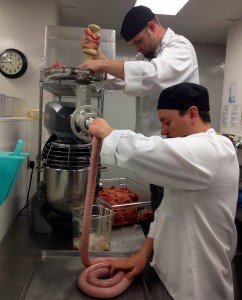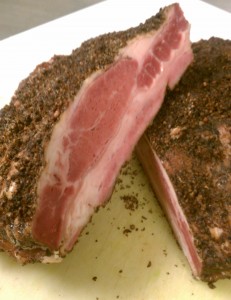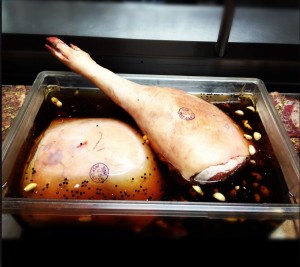Chefs Apply “From Scratch” Principle to Bacon, Sausage, and More
Once a way to preserve meat without refrigeration, charcuterie – the branch of cooking devoted to preparing bacon, ham, sausage, terrines, galantines, pâtés, and confit – has become a trendy art to learn within the culinary world. It’s also a popular cooking technique among devotees of sustainable food, because it utilizes parts of the animal that would otherwise be discarded. Making charcuterie isn’t easy, but Bon Appétit Management Company chefs all across the country are embracing the challenge!
At Paradise Café in San Jose, CA, Executive Chef David Anderson and Chef De Cuisine Alex are working on a new “butcher shop and smokehouse” within the café, and have found many reasons to make sausage and pastrami from scratch. They can get creative with flavors, such as Thai Isan Sausage, a sour sausage with rice, pork, kaffir lime, lemongrass, ginger and garlic. Traditionally it is fermented in the sun, but David and Alex added fish sauce to the recipe instead.

Executive Chef John Dirks and Catering Chef Ryan McTighe making Italian sausage at VMware
From-scratch charcuterie also means they can purchase more whole animals, because the trim provides the key ingredients for sausage production. By making sausage within the café, they’ve also been able to purchase more meat from Farm to Fork vendors such as Marin Sun Farms. David said, “I strongly believe that if we choose to serve meat in our kitchens, then we should do our best to waste as little of that animal as possible. Charcuterie methods help to utilize the whole animal, and doing so — as well as butchering in-house — reduces the cost.”
Of the curing and smoking process, Alex said, “It’s not a practice for novices. Curing and brining take know-how, to make the proper mixture of ingredients… and smoking takes just as much practice as anything else. There can’t be too much heat, or too little.” The pastrami is made from Marin Sun Farms beef navel (the cut traditionally used to make “real” pastrami, which is fattier than brisket and closer to pork belly). Although it’s not an easy task, Alex said, “Making our own pastrami was born from the fact that if we have the tools to make anything on our own, why not make it?”
Across town at VMWare in Palo Alto, CA, Executive Chef John Dirks is also making pork sausage and has made lamb sausage in the past. According to John, the VMWare team decided to make its sausage in-house because “we can make it the way we want it and we can control the fat ratio and spice intensity.” He admits it is time-consuming, but that with a plan in place, it comes together well and is worth the extra effort.
At our State Auto Insurance kitchen in Indianapolis, IN, meanwhile, Chef Manager Lewis Hites is curing bacon and ham with locally raised pigs from Gunthrop Farms. Curing bacon and ham in-house means more control over not only flavors and saltiness, but also nitrates, he says.
All of the cure-it-yourselfers above say that their customers value the time the chefs are taking with these products and get excited when they see them on the menu. Plus, making and curing meat in-house allows chefs to pack many of Bon Appétit’s values — from-scratch cooking, reducing food waste, and supporting local farmers and ranchers — into each tasty bite.

